In this post, I would like to take a closer look at one of the smallest and yet most beautiful churches that is connected with the events of Passion Week: the final week that Jesus spent in Jerusalem. Located on the western slope of the Mount of Olives, just east of Jerusalem’s Old City, this modest Roman Catholic church is known as Dominius Flevit.
The name means “the Lord cried” in Latin, a reference to Jesus weeping over the future destruction of the Temple during his triumphal entry into the city on Palm Sunday. Let’s look at the relevant passage, which is found only in the Gospel of Luke:
As he approached Jerusalem and saw the city, he wept over it and said, “If you, even you, had only known on this day what would bring you peace—but now it is hidden from your eyes. The days will come upon you when your enemies will build an embankment against you and encircle you and hem you in on every side. They will dash you to the ground, you and the children within your walls. They will not leave one stone on another, because you did not recognize the time of God’s coming to you. Luke 19:41-44
Like the great Hebrew prophets Isa. 29:3-10; Jer. 8:18-21 that predicted the destruction of Jerusalem by the Babylonians six centuries earlier, Jesus prophecies the Roman destruction of the city in his own generation. Although this is not the only place in the Gospels that Jesus prophecies the future destruction of Jerusalem Luke 21:20-24, this passage contains the most violent language. Jesus predicts that enemies will tear down the Temple, not leaving “one stone upon another, because you did not recognize the time of your visitation” Luke 19:44. What does the phrase “your visitation” refer to? Most people assume this means God’s visit to the city in the person of Jesus. This certainly is one level of meaning, but if we read the passage in the original Greek, another level emerges. The word “visitation” in Greek is episkopē meaning “watching over”. It is the root of the word “episcopal” which means “having to do with a bishop”, the “overseer” of a church. So Jesus is also saying Jerusalem will fall because its inhabitants did not recognize their own obligation to “watch over” it. The ruling class was too busy with their own private affairs to adequately care for the disenfranchised and too corrupt to adequately care for the public character of the city. As predicted, this lack of “oversight” resulted in the destruction of the city by the Romans only forty years after Jesus visited it.
The present church on this site dates to the 1950s and was designed by the celebrated Italian architect Antonio Barluzzi who is responsible for many other Franciscan churches in the Holy Land. Barluzzi strove to have the form of each church he designed reflect the essence of the relevant Scriptural passage commemorated. Accordingly, Domius Flevit is a small chapel with a high pointed dome that is meant to evoke the shape of a tear, a reference to weeping of Jesus that happened on this site.
Four jars surround the cupola; these are phials, vessels used to gather tears in ancient Greco-Roman funerary art. A similar concept is expressed in Psalm 56:8. In addition, the church’s apse contains a beautiful window facing the Temple Mount (which is west rather than east as in most churches) in order to memorialize the exact view that Jesus had when he stood on this very site. The altar contains a modern mosaic of a hen protecting her chicks, a reference to a related prophecy uttered by Jesus earlier in Luke:
Jerusalem, Jerusalem, you who kill the prophets and stone those sent to you, how often I have longed to gather your children together, as a hen gathers her chicks under her wings, and you were not willing. Luke 13:34
The modern church of Dominus Flevit is built upon the foundations of an earlier Byzantine church which faced east. Extensive remains of the ancient mosaic floor of this 7th century monastery church are still visible. The Greek dedication inscription reads: “Simon, friend of Christ, who built and decorated this place of prayer and offered it to Christ our Lord in expiation of his sins…”
Adjacent to the church a well preserved burial cave dating to the Second Temple Period was discovered by the famous Catholic archaeologist and Franciscan priest Bellarmino Camillo Bagatti. Like many similar Jewish cave complexes found in the hills and valleys surrounding the Old City of Jerusalem, this cave contains several niches (Hebrew kokhim) that held a dead body for a year until the flesh had decomposed. Subsequently, the bones were gathered and placed in an ossuary, a bone box, to await to the arrival of the Messiah.




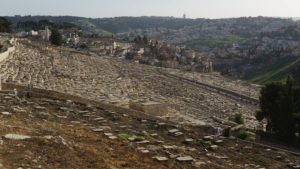
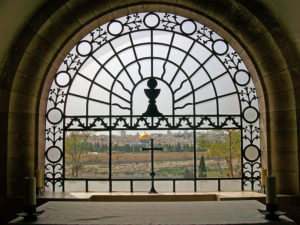
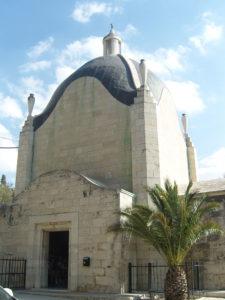
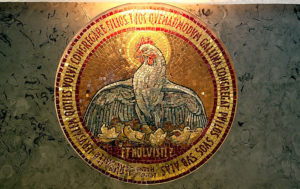

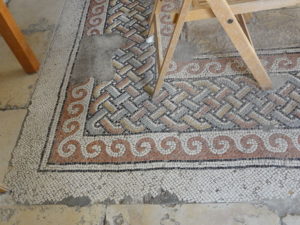


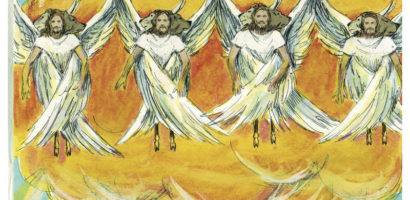
Your articles add so much depth to my morning Bible reading. Thank you for taking the time to put this information out there for those of us who are Bible students, but not Bible scholars. Please keep it up.
Thank you for the blessing of insight, I appreciate it very much.
Beautiful chapel or Sanctuary, that I have visited myself, but this blog described in such comprehensive details I could not see completely on my brief visit. I will recommend this blog to friends and members of my religious community.
The Talmud (Yoma 9b) tells us that the reason for the destruction of Jerusalem in 70 C.E. was the bitter conflict between the priests and the animosity between the temple leaders resulting in God removing His protection so that they became vulnerable to their enemies. [Find such confirmation on the wall inside the “Burnt House” in Jerusalem.] Presumable these are the same families who engineered Yeshua (Jesus’) death a generation earlier. Yeshua tells us in Matthew 24:12 in answer to his disciples’ questions about what will take place in the days of His coming (or last days of this age), He says, “…the love of most will grow cold because of their lawlessness.” In context it would seem that He is speaking of “Torahlessness,” Biblelessness! Those engaged in bitterness and competition are not likely to be biblically aware. Those who are truly biblically savvy are likely to be those who pray, including informed prayer for “the peace of Jerusalem” – for Jerusalem’s sake which will inevitably extend to the peace of the entire world.
Our life how we live it before God and men.
Thought provoking Blog. As I reflected on the scriptures and your pictures & words I thought about Josephus’s account of the destruction of Jerusalem, and the words of JESUS. Then I was reminded about the prophesy in Ezekiel 36:24 that The LORD would restore His people into their land.